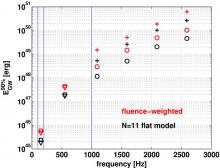
Abstract
We present the results of a LIGO search for short-duration gravitational waves (GWs) associated with the 2006 March 29 SGR 1900+14 storm. A new search method is used, "stacking'' the GW data around the times of individual soft-gamma bursts in the storm to enhance sensitivity for models in which multiple bursts are accompanied by GW emission. We assume that variation in the time difference between burst electromagnetic emission and potential burst GW emission is small relative to the GW signal duration, and we time-align GW excess power time-frequency tilings containing individual burst triggers to their corresponding electromagnetic emissions. We use two GW emission models in our search: a fluence-weighted model and a flat (unweighted) model for the most electromagnetically energetic bursts. We find no evidence of GWs associated with either model. Model-dependent GW strain, isotropic GW emission energy E_GW, and \gamma = E_GW / E_EM upper limits are estimated using a variety of assumed waveforms. The stacking method allows us to set the most stringent model-dependent limits on transient GW strain published to date. We find E_GW upper limit estimates (at a nominal distance of 10 kpc) of between 2x10^45 erg and 6x10^50 erg depending on waveform type. These limits are an order of magnitude lower than upper limits published previously for this storm and overlap with the range of electromagnetic energies emitted in SGR giant flares.